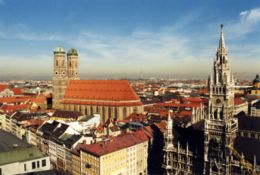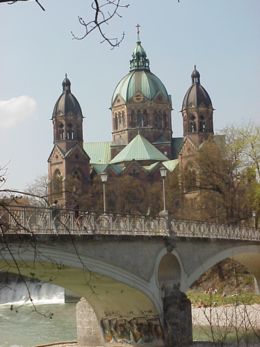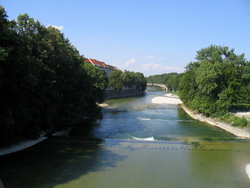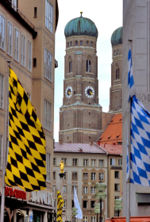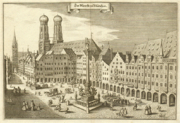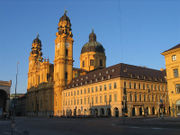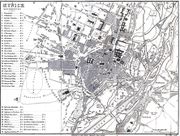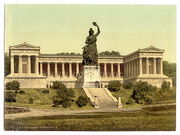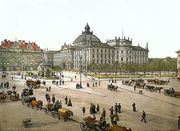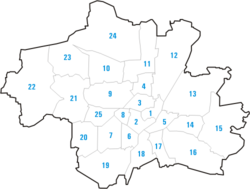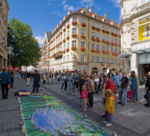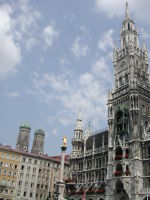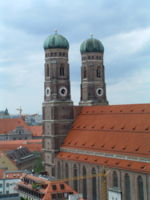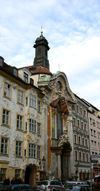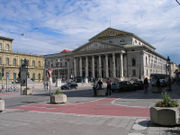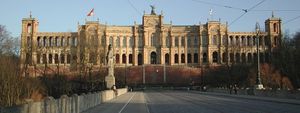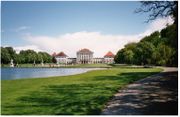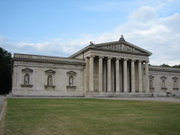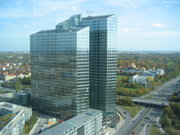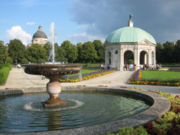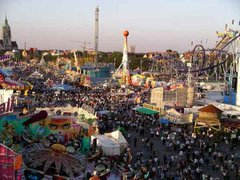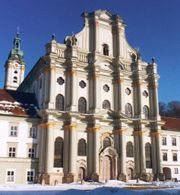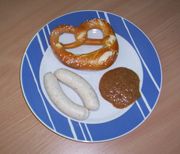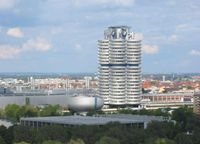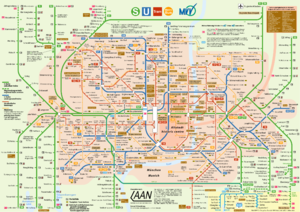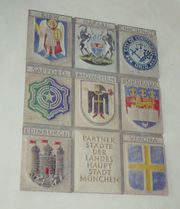Munich
2007 Schools Wikipedia Selection. Related subjects: European Geography
| Munich (München) | |
|---|---|
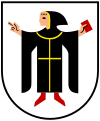 |
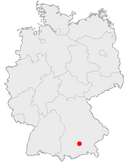 |
|
|
|
| Country | Germany |
| State | Bavaria (Bayern) |
| Administrative region | Upper Bavaria |
| District | urban district |
| Population | 1,314,551 (August 2006) |
| Area | 310.43 km² |
| Population density | 4,205 / km² |
| Elevation | 519 m |
| Coordinates | 48°08′ N 11°34′ E |
| Postal code | 80000–81929 |
| Area code | 089 |
| Licence plate code | M |
| Mayor | Christian Ude ( SPD) |
| Website | muenchen.de |
Munich (German: München, pronounced [ˈmʏnçən] ![]() listen) is the capital of the German Federal State of Bavaria (German: Freistaat Bayern).
listen) is the capital of the German Federal State of Bavaria (German: Freistaat Bayern).
Munich is Germany's third largest city and one of Europe's most prosperous and expensive. The city has a population of about 1.3 million ( as of 2006) and the Munich metropolitan area is home to around 2.7 million people. The city is located on the River Isar north of the Bavarian Alps.
The city's motto was "Die Weltstadt mit Herz" (The world city with a heart) for a long time but has recently been replaced by "München mag dich" (Munich loves you). The figure on Munich's coat-of-arms is a monk referred to as the Münchner Kindl, the child of Munich. Black and gold - the colours of the Holy Roman Empire - have been the city's official colours since the time of Louis IV, Holy Roman Emperor.
Geography
Setting
Munich lies on the elevated plains of Upper Bavaria, about 50 km north of the northern edge of the Alps, at an altitude of about 520 m.
Munich is situated in the Northern Alpine Foreland. The northern part of this sandy plateau includes a highly fertile flint area which is no longer affected by the folding processes found in the Alps, while the southern part is covered by morainic hills. In between there are fields of fluvio-glacial out-wash, like around Munich. Wherever these deposits get thinner, the ground water can permeate the gravel surface and flood the area, leading to marshes as in the north of Munich.
Climate
Because of the city's altitude and proximity to the northern edge of the Alps, precipitation is rather high. Rain storms often come violently and unexpectedly. The range of temperature between day and night or summer and winter can be extreme. A warm downwind from the Alps ( Föhn) can change the temperatures completely within a few hours, even in the winter. Winters last from December to March. Munich experiences rather cold winters, but heavy rainfall is rarely seen in the winter. The coldest month is January with an average temperature of 1° C (33° F). Snow cover is seen for at least a couple of weeks during winter. Summers in Munich city are fairly warm with average temperature of 19° C (67° F) in the hottest month of July. The summers last from May till August. In the summer, there is frequent rainfall accompanied by thunderstorms.
History
Origin
As foundation date the year 1158 is assumed which is the earliest date the city is mentioned in a document. By that time the Guelph Henry the Lion, Duke of Saxony and Bavaria, had built a bridge over the river Isar next to a settlement of Benedictine monks. The monks' presence dated back to the 8th century, although settlement in the Munich area can be traced back to Roman times. To force traders to use his bridge (and charge them for doing so) Henry also destroyed a nearby bridge owned by bishop Otto von Freising ( Freising). Subsequently the bishop and Henry quarreled about the city before Emperor Frederick I Barbarossa at an Imperial Diet held in Augsburg in 1158. This sanctioned Henry's spoliation, and awarded an annual compensation for the bishop, and also confirmed Munich's trading and currency rights.
Middle Ages
Almost two decades later in 1175 Munich was officially granted city status and fortified. In 1180, with the trial of Henry the Lion, Otto I Wittelsbach became Duke of Bavaria and Munich was handed over to the bishop of Freising. Otto's heirs, the Wittelsbach dynasty would rule Bavaria until 1918. In 1240 Munich itself was transferred to Otto II Wittelsbach and in 1255, when the dukedom of Bavaria was split in two, Munich became the ducal residence of Upper Bavaria.
Duke Louis IV was elected German king in 1314 and crowned as Holy Roman Emperor in 1328. He strengthened the city's position by granting it the salt monopoly, thus assuring it of additional income. In 1327 most of the city was destroyed by a fire but was rebuilt, extended and protected with a new fortification some years later. Philosophers like Michael of Cesena, Marsilius of Padua and William of Ockham supported Louis IV in his fight with the papacy and were protected at the emperor's court. Since the citizenry several times revolted against the dukes a new castle was built close to the fortification from 1385 onwards. A rising of the guilds in 1397 was thrown down the following year.
Another devastating fire destroyed parts of the city in 1429. Since the town fathers considered themselves threatened by the Hussites the fortification was extended. In the late 15th century Munich underwent a revival of gothic arts - the Old Town Hall was enlarged and a new cathedral - the Frauenkirche - constructed within only twenty years from 1468 onwards. The cathedral has become a symbol for the city with its two brick towers and onion domes.
Capital of the reunited duchy of Bavaria
When Bavaria was reunited in 1506 Munich became capital of the whole of Bavaria. The arts and politics became increasingly influenced by the court. During the 16th century Munich was a centre of the German counter reformation, and also of renaissance arts. Duke Wilhelm V commissioned the Jesuit Michaelskirche, which became a centre for the counter-reformation, and also built the Hofbräuhaus for brewing brown beer in 1589.
The Catholic League was founded in Munich in 1609. In 1623 during the Thirty Years' War Munich became electoral residence when Maximilian I, Duke of Bavaria was invested with the electoral dignity but in 1632 the city was occupied by Gustav II Adolph of Sweden. When the bubonic plague broke out in 1634 and 1635 about one third of the population died. After the war Munich quickly became a centre of baroque life. Elector Ferdinand Maria’s consort Henriette Adelaide of Savoy invited numerous Italian architects and artists to the city, and built the Theatinerkirche and Nymphenburg palace on the occasion of the birth of their son and heir Maximilian II Emanuel, elector of Bavaria in 1662.
Munich was under the control of the Habsburg family for some years after Maximilian II Emanuel had made a pact with France in 1705 during the War of the Spanish Succession. The occupation led to bloody uprisings against the Austrian imperial troops followed by a massacre while farmers were rioting (the "Sendlinger Mordweihnacht" or Murder Christmas of Sendling). The coronation of Max Emanuel's son elector Charles Albert as Emperor Karl VII in 1742 led to another Habsburg occupation. The city's first academic institution, the Bavarian Academy of Sciences, was founded in 1759 by Maximilian III Joseph, who abandoned his forefather's imperial ambitions and made peace. From 1789 onwards, when the old medieval fortification was demolished, the English Garden was laid out - it is one of the world's largest urban public parks. By that time, the city was growing very quickly and was one of the largest cities in continental Europe.
Capital of the Kingdom of Bavaria
In 1806, it became the capital of the new Kingdom of Bavaria, with the state's parliament (the Landtag) and the new archdiocese of Munich and Freising being located in the city. Twenty years later Landshut University was moved to Munich.
Many of the city's finest buildings belong to this period and were built under the reign of King Ludwig I. These neoclassical buildings include the Ruhmeshalle with the "Bavaria" statue by Ludwig Michael von Schwanthaler and those on the magnificent Ludwigstraße and the Königsplatz, built by the architects Leo von Klenze and Friedrich von Gärtner. Under King Max II the Maximilianstraße was constructed in Perpendicular style.
The railways reached Munich in 1839, followed by trams in 1876 and electric lighting in 1882. The Technical University of Munich was founded in 1868. The city hosted Germany's first exhibition of electricity, and in 1930 the first ever television was showcased at the city's Deutsches Museum (founded in 1903) on the banks of the Isar. Numerous inventors and scientists worked in Munich, including Alois Senefelder, Joseph von Fraunhofer, Justus von Liebig, Georg Ohm, Carl von Linde, Rudolf Diesel, Wilhelm Conrad Röntgen, Emil Kraepelin and Alois Alzheimer, and the young Albert Einstein attended the Luitpold Gymnasium. In 1901 the Hellabrunn Zoo opened in the city.
Munich also became a centre of the arts and literature again, as Carl Rottmann, Wilhelm von Kaulbach, Carl Spitzweg, Franz von Lenbach, Franz von Stuck, Wilhelm Leibl, Paul Heyse, Henrik Ibsen, Richard Wagner, Richard Strauss and many others lived and worked there.
The period immediately before World War I saw particular economic and cultural prominence for the city. Munich, and especially its suburb of Schwabing, became the domicile of many artists and writers. Thomas Mann wrote about this period "Munich shone". Der Blaue Reiter (The Blue Rider), a group of expressionist artists, was established in Munich in 1911. The city was a home for painters like Paul Klee, Wassily Kandinsky, Alexej von Jawlensky, Gabriele Münter, Franz Marc, August Macke and Alfred Kubin and for numerous writers like Rainer Maria Rilke and Frank Wedekind. In 1846 Munich's population was about 100,000, and by 1901 this had risen to about 500,000.
World War I and revolution
Following the outbreak of World War I in 1914, life in Munich became very difficult, as the Allied blockade of Germany led to food and fuel shortages. During French air raids in 1916 three bombs fell on Munich. After World War I, the city was at the centre of much political unrest. In November 1918 on the eve of revolution, Ludwig III and his family fled the city. After the murder of the first republican premier of Bavaria Kurt Eisner in February 1919 by Anton Graf von Arco-Valley, a member of the right-wing Thule Gesellschaft (Thule Society), the Munich Soviet Republic (Münchner Räterepublik) was proclaimed. After Communists had taken power, Lenin, who had lived in Munich some years before, sent a congratulatory telegram, but the Soviet Republic was put down on May 3, 1919 by the Freikorps. After the Räterepublik had been brutally put down and the republican government had been restored, Munich subsequently became a hotbed of right-wing politics, among which Adolf Hitler and the Nazis rose to prominence.
Weimar Republic / Nazi Regime and World War II
In 1923 Hitler and his supporters, who at that time were concentrated in Munich, staged the Beer Hall Putsch, an attempt to overthrow the Weimar Republic and seize power. The revolt failed, resulting in Hitler's arrest and the temporary crippling of the Nazi Party, which was virtually unknown outside Munich.
Munich remained a centre of cultural life during the Weimar period, as figures such as Lion Feuchtwanger, Bert Brecht and Oskar Maria Graf were active.
The city however would once again become a Nazi stronghold when they took power in Germany in 1933. Because of its importance to the rise of Nazism, the Nazis called it the Hauptstadt der Bewegung ("capital of the movement"). The NSDAP headquarters were in Munich and many Führerbauten ("Führer-buildings") were built around the Königsplatz, some of which have survived to this day. During the Night of the Long Knives in 1934 Hitler eliminated potential political rivals.
In 1938, the Munich Agreement, Neville Chamberlain's famous act of appeasement to Hitler, was signed in the city by representatives of Germany, Italy, France and Britain. It ceded the mostly German-speaking regions of Czechoslovakia called Sudetenland to Germany. One year later Georg Elser failed with his attempt to assassinate Hitler during his annual speech to commemorate the Beer Hall Putsch in the Bürgerbräukeller in Munich.
Munich was the base of the White Rose (German: Die Weiße Rose), a group of students that formed a resistance movement from June 1942 to February 1943. The core members were arrested and executed following a distribution of leaflets in Munich University by Hans and Sophie Scholl.
The city was very heavily damaged by allied bombing during World War II - the city was hit by 71 air raids over a period of five years.
Postwar Munich
After American occupation in 1945, Munich was completely rebuilt following a meticulous and - by comparison to other war-ravaged German cities - rather conservative plan which preserved its pre-war street grid.
In 1957 Munich's population passed the 1 million mark.
Munich was the site of the 1972 Summer Olympics, during which Israeli athletes were assassinated by Palestinian terrorists (see Munich massacre), when terrorist gunmen from the Palestinian " Black September" group took hostage members of the Israeli Olympic team. A rescue attempt by the West German government was unsuccessful and resulted in the deaths of the Israeli hostages, five of the terrorists, and one German police officer.
Several games of the 1974 World Cup were also held in the city, including the German triumph against the Netherlands in a legendary final. Several games of the 2006 World Cup were also held in Munich.
In 1992 Munich’s new airport was inaugurated and the inauguration of the Neue Messe, the new exhibition centre on the site of the former airport of Riem, took place in 1998.
The current (2006) Roman Catholic Pope Benedict XVI (Joseph Ratzinger) was ordained a priest in the Archdiocese of Munich and Freising on June 29, 1951. Ratzinger served as Archbishop of Munich from 1977 to 1982.
Politics
Munich's current mayor is Christian Ude of the SPD (Social Democratic Party of Germany). Munich has a nearly unbroken history of SPD governments since World War II, which is remarkable because the rest of Bavaria is a conservative stronghold, with the CSU (Christian Social Union) winning absolute majorities among the Bavarian electorate in nearly all elections at the communal, state, and federal levels.
As capital of Bavaria, Munich is an important political centre in Germany and the seat of the Bavarian Landtag (the state parliament), the Staatskanzlei (the state chancellery) and of all state departments.
Several national and international authorities are located in Munich, including the Bundesfinanzhof (the highest German tax court) and the European Patent Office.
Subdivisions
Munich is subdivided into 25 boroughs (Bezirke in German, also sometimes called districts in English).
Allach-Untermenzing (23), Altstadt-Lehel (1), Aubing-Lochhausen-Langwied (22), Au-Haidhausen (5), Berg am Laim (14), Bogenhausen (13), Feldmoching-Hasenbergl (24), Hadern (20), Laim (25), Ludwigsvorstadt-Isarvorstadt (2), Maxvorstadt (3), Milbertshofen-Am Hart (11), Moosach (10), Neuhausen-Nymphenburg (9), Obergiesing (17), Pasing-Obermenzing (21), Ramersdorf-Perlach (16), Schwabing-Freimann (12), Schwabing-West (4), Schwanthalerhöhe (8), Sendling (6), Sendling-Westpark (7), Thalkirchen-Obersendling-Forstenried-Fürstenried-Solln (19), Trudering-Riem (15) and Untergiesing-Harlaching (18).
Main sights and culture
Munich is a popular tourist destination and has been described as Germany's "secret capital".
Marienplatz and Stachus
At the centre of the city is the Marienplatz - a large open square named after the Mariensäule, a Marian column in its centre - with the Old and the New Town Hall. Its tower contains the Rathaus-Glockenspiel, an ornate clock with almost life-sized moving figures that show scenes from a medieval jousting tournament as well as a performance of the famous "Schäfflertanz" (roughly translated "Barrel-makers' dance"). Three gates of the demolished medieval fortification have survived to this day - the Isartor in the east, the Sendlinger Tor in the south and the Karlstor in the west of the inner city. The Karlstor is the oldest building at Stachus, a grand square dominated by the Justizpalast (Palace of Justice).
Houses of worship
The Peterskirche close to Marienplatz is the oldest church of the inner city. It was first built during the romanesque period, and was the focus of the early monastic settlement in Munich before the city's official foundation in 1158. The oldest church within the city borders is Heilig Kreuz in Fröttmaning next to the Allianzarena, known for its Romanesque fresco. Nearby St. Peter the gothic hall-church Heiliggeistkirche (The Church of the Holy Ghost) was converted to baroque style from 1724 onwards and looks down upon the Viktualienmarkt, the most popular market of Munich.
The Frauenkirche ("Dom zu unserer Lieben Frau" - Cathedral of Our Lady) is the most famous building in the city centre and serves as cathedral for the Archdiocese of Munich and Freising. It is particularly famous for the brass onion domes that top the twin towers. The domes were added in the 16th century, in a style that contrasted with the gothic style of the rest of the building. The original design called for pointed towers like Cologne Cathedral but they were never completed due to lack of money. At first glance the two towers appear to be the same height but in fact one is slightly taller than the other. Unlike most buildings in Munich's old town, the towers of the Frauenkirche (but not the church itself) survived WW2 intact, making them more than 500 years old. The Frauenkirche's towers (99 meters or 325 feet) are also the measurement for a new rule which limits the height of new buildings to the same height in the city. This rule was passed in November 2004 by the people of Munich in a referendum organized by Georg Kronawitter, a former SPD mayor, despite opposition from the political parties in the city's parliament ("Stadtrat") who feared that it would harm the city's attractiveness to investors. Other gothic churches are the former graveyard chapels of St. Peter, the Kreuzkirche, and of the Frauenkirche, St Salvator but also the former Augustinerkirche which serves today as German Hunting and Fishing Museum.
The nearby Michaelskirche is the largest renaissance church north of the Alps, while the Theatinerkirche is a basilica in Italianate high baroque which had a major influence on Southern German baroque architecture. Its dome dominates the Odeonsplatz. Other baroque churches in the inner city which are worth a detour are the Bürgersaalkirche, the Dreifaltigkeitskirche, the St. Anna Damenstiftskirche and St. Anna im Lehel, the first rococo church in Bavaria. The Asamkirche was endowed and built by the Brothers Asam, pioneering artists of the rococo period. St Michael in Berg am Laim was built almost simultaneously by Johann Michael Fischer and might be the most remarkable church out of the inner city.
With the 19th century architectural revival styles many new catholic churches were constructed also in Munich. Since Middle Franconia whose population is predominantly of Protestant origin was annexed by Bavaria the first Protestant churches St Mathaeus, St. Martin and St. Lukas in Munich were erected in this period as well.
On November 9th 2006 the new Ohel Jakob synagogue was opened on Sankt-Jakobs-Platz, 68 years after the massive Kristallnacht pogrom .
A new mosque is planned not far from the city centre on a vacant lot. An Islamic prayer house still exists in the vicinity but the plans for a bigger and more representative building face to face with a catholic church are discussed controversely.
The palaces, royal avenues and theatres
The Alte Hof, a medieval castle and first residence of the Wittelsbach dukes in Munich still exists in the inner city close to Marienplatz. The Renaissance Mint Yard with its neoclassical façade is situated between the old castle and the Residenz.
The large Residenz palace complex (begun in 1385) on the edge of Munich's Old Town ranks among Europe's most significant museums of interior decoration. Having undergone several extensions, it contains also the treasury and the splendid rococo Cuvilliés Theatre. Many operas were staged here, including the premiere of Mozart's "Idomeneo" in 1781.
Munich is home to a neo-classical opera house of international renown, the Nationaltheater where several of Richard Wagner's operas had their premieres under the patronage of Ludwig II of Bavaria. Today it is the home of the Bavarian State Opera and the Bavarian State Orchestra. Next door the modern Residenz Theatre was erected in the building that had housed the Cuvilliés Theatre before World War II. The Gärtnerplatz Theatre is a ballet and musical state theatre on the left bank of the Isar in the south of the inner city. The modern Gasteig centre on the opposite bank houses the Munich Philharmonic Orchestra. The third orchestra in Munich with international importance is the Bavarian Radio Symphony Orchestra. Close to the Gasteig on the bank of the Isar is the Volksbad, a large public bath built in the art nouveau style.
Among the baroque and neoclassical mansions which still exist in Munich are the Palais Törring-Jettenbach with its loggia, the Palais Preysing, the Palais Holnstein (the residence of the Archbishop of Munich and Freising), the Palais Leuchtenberg (the former residence of Eugène de Beauharnais) and the Prinz-Carl-Palais, the official residence of Bavaria's state premier (or Ministerpräsident). All mansions are situated close to the Residenz.
Four grand royal avenues of the 19th century with magnificent official buildings are reminders of the kingdom of Bavaria:
Brienner Strasse, starting at Odeonsplatz on the northern fringe of the Old Town close to the Residenz, runs from east to west and opens into the impressive Königsplatz, designed with the " Doric" Propyläen, the " Ionic" Glyptothek and the " Corinthian" State Museum of Classical Art, on its back side St. Boniface's Abbey was erected. The area around Königsplatz is home to the Kunstareal, Munich's gallery and museum quarter (as described below).
The neoclassical Ludwigstrasse also begins at Odeonsplatz and runs from south to north, skirting the Ludwig-Maximilians-Universität, the St. Louis church, the Bayerische Staatsbibliothek ( Bavarian State Library) and numerous state ministries and palaces.
Maximilianstrasse starts at Max-Joseph-Platz, where the Residenz and the National Theatre are situated, and runs from west to east. The avenue is framed by neogothic palaces which house, among others, the Schauspielhaus (one of the most important German language theatres in the world), the building of the district government of Upper Bavaria and the Völkerkundemuseum (Museum of Ethnology). After crossing the river Isar, the avenue circles the Maximilianeum, home of the Bavarian Landtag (state parliament). The western portion of Maximilianstrasse is known for its designer shops, luxury boutiques, jewellery stores, and one of Munich's foremost five-star hotels, the Hotel Vier Jahreszeiten (Four Seasons).
Prinzregentenstrasse runs parallel to Maximilianstrasse and begins at Prinz-Carl-Palais, in the northeastern part of the Old Town. Many museums can be found along the avenue, such as the internationally renowned Haus der Kunst (House of Art), the Bayerisches Nationalmuseum ( Bavarian National Museum), the Schackgalerie and the Villa Stuck on the eastern side of the river. The avenue crosses the river and circles the Friedensengel (Angel of Peace), a monument commemorating the 25 years of peace following the Franco-Prussian War in 1871. The Prinzregententheater, another important theatre, is at Prinzregentenplatz further to the east.
Two large baroque palaces in Nymphenburg and Oberschleissheim are reminders of Bavaria's royal past. Schloss Nymphenburg ( Nymphenburg Palace), some 6 km north west of the city centre, is surrounded by an impressive park and is considered to be one of Europe's most beautiful royal residences. 2 km north west of Nymphenburg Palace is Schloss Blutenburg ( Blutenburg Castle) situated, an old ducal country seat with a late-Gothic palace church. Schloss Fürstenried ( Fürstenried Palace), a baroque palace of similar structure to Nymphenburg but of much smaller size, was contemporaneously erected in the south west of Munich. The second large baroque residence is Schloss Schleißheim ( Schleissheim Palace), located in the suburb of Oberschleissheim, a palace complex encompassing three separate residences: Altes Schloss Schleißheim (the old palace), Neues Schloss Schleißheim (the new palace) and Schloss Lustheim (Lustheim Palace). Most parts of the palace complex serve as museums and art galleries. Deutsches Museum's Flugwerft Schleißheim flight exhibition centre is located nearby, on the Schleißheim Special Landing Field.
The museums
The Deutsches Museum, located on an island in the Isar, is one of the oldest and largest science museums in the world. Three redundant exhibition buildings which are under a protection order were converted to house the Verkehrsmuseum, which houses the land transport collections of the Deutsches Museum. Several still not centralised museums show the expanded state collections of palaeontology, geology, mineralogy, zoology, botany and anthropology.
The city has several important art galleries, most of which can be found in the Kunstareal, including the Alte Pinakothek, the Neue Pinakothek, and the Pinakothek der Moderne. Alte Pinakothek's rather monolithic structure contains a treasure trove of the works of European masters between the 14th and 18th centuries. The collection reflects the eclectic tastes of the Wittelsbachs over four centuries, and is sorted by schools over two sprawling floors. Major displays include Albrecht Dürer`s Christ-like Self-Portrait, his Four Apostles, Raffael's paintings The Canigiani Holy Family and Madonna Tempi as well as Peter Paul Rubens two-storey-high Judgment Day. The gallery houses one of the world's most comprehensive Rubens collections. Before World War I, the Blaue Reiter group of artists worked in Munich. Many of their works can now be seen at the Lenbachhaus. An important collection of Greek and Roman art is held in the Glyptothek and the Staatliche Antikensammlung (State Antiquities Collection). Louis I managed to acquire such famous pieces as the Medusa Rondanini, the Barberini Faun and the figures from the Temple of Aphaea on Aegina for the Glyptothek. The Kunstareal will be further augmented by the completion of the Egyptian Museum.
The famous gothic Morris dancers of Erasmus Grasser are exhibited in the Munich City Museum in the old arsenal building. The State Museum of Ethnology in Maximilianstrasse is the second largest collection in Germany of artifacts and objects from outside Europe, while the Bavarian National Museum and the adjoining State Archeological Collections in Prinzregentenstrasse rank among Europe's major art and cultural history museums. The nearby Schackgalerie is an important gallery of German 19th century paintings.
Modern Munich
Munich features a wide and diverse array of modern architecture, although strict height limitations for buildings have limited the construction of skyscrapers. Most high-rise buildings are clustered at the northern edge of Munich, like the Hypohaus, the Arabella High-Rise Building, the Highlight Towers, Uptown Munich and the BMW Headquarters next to the Olympic Park. Several other high-rise buildings are located near the city centre and on the Siemens campus in southern Munich. A landmark of modern Munich is also the architecture of the sport stadiums (see below).
In November 2004, a referendum was held to decide whether the construction of high-rise buildings in the inner city should be prohibited; as a result of the referendum, several building projects, among them the planned new office building of Süddeutscher Verlag, had to be changed substantially or given up completely. However, as of 2006, due to the very close result of the referendum and due to the fact that the referendum's result was binding only for one year, there is an ongoing discussion in the city council on how to proceed with future building plans.
The parks
Munich is a green city with numerous parks. The Englischer Garten, close to the city centre and covering an area of 3.7 km², is one of the world's largest urban public parks, and contains a nudist area, jogging tracks and bridle-paths. Other large green spaces are the modern Olympic Park, and the parks of Nymphenburg Palace (with the Botanical Garden to the north), and Schleissheim Palace. The city's oldest park is the Hofgarten, near the Residenz, and dating back to the 16th century. Most known for the largest beergarden in the town is the former royal Hirschgarten, founded in 1780 for deer which still live there. The city's zoo is the Tierpark Hellabrunn near the Flaucher Island in the Isar in the south of the city. Another notable park is Ostpark, located in Perlach-Rammersdorf area which houses the swiming area , Michealibad, one of the largest in Munich.
Hofbräuhaus and Oktoberfest
Main article: Oktoberfest
The Hofbräuhaus am Platzl is arguably the most well-known beer hall, located in the city centre. It also operates the second largest tent at the Oktoberfest, perhaps Munich's most famous attraction. A 2-week-long fair, it offers a wide selection of rollercoasters and several large beer tents ("Bierzelte"). The Oktoberfest was first held on October 12, 1810 in honour of the marriage of crown prince Ludwig to Princess Therese von Sachsen-Hildburghausen. The festivities were closed with a horse race and in the following years the horse races were continued and later developed into what is now known as the Oktoberfest. Despite its name, most of Oktoberfest occurs in September. It always finishes on the first Sunday in October unless the German national holiday on 3 October ("Tag der deutschen Einheit" - Day of German Unity) is a Monday or Tuesday - then the Oktoberfest still opens for these days.
Others
- Dallmayr
Around Munich
The Munich agglomeration sprawls across the plain of the Voralpenland. Several smaller traditional Bavarian towns are today part of the Munich suburbs:
- Dachau
- Erding
- Fürstenfeldbruck
- Freising
- Garching bei München
- Germering
- Gräfelfing
- Gröbenzell
- Grünwald
- Gauting
- Haar
- Germering
- Oberschleissheim
- Planegg
- Starnberg
- etc.
Lifestyle
Residents of Munich typically enjoy a high quality of life. Mercer HR Consulting consistently rates the city among the top 10 cities with highest quality of life worldwide - a 2005 survey ranked Munich as 7th. Munich enjoys a thriving economy, driven by the information technology, biotechnology, and publishing sectors. Environmental pollution is comparatively low, although as of 2006 the city council is concerned about levels of particulate matter (PM), especially along the city's major thoroughfares. Since the enactment of EU legislation concerning the concentration of particulate in the air, environmental groups such as Greenpeace have staged large protest rallies to urge the city council and the State government to take a harder stance on pollution.
Public transport is very efficient, although delays on the S-Bahn (commuter train) often cause frustration during extreme winter weather. The crime rate is very low compared to other large German cities, such as Hamburg or Berlin. This high quality of life and safety has caused the city to be nicknamed "Toytown" amongst some of the English-speaking residents. German inhabitants call it “Millionendorf”, which means “village of a million people”. Some also refer to it as "Weltstadt mit Herz" which was the official city slogan for some years and means "world city with a heart".
The Viktualienmarkt is Munich's most popular market for fresh food and delicatessen. A very old feature of Munich's Fasching (carnival) is the dance of the Marktfrauen (market women) of the Viktualienmarkt in comical costumes.
The Auer Dult is held three times a year on the square around Mariahilf church and is one of Munich's oldest markets, well known for its jumble sale and antiques. Almost 300 stands offer rare books and old prints, haberdashery goods, natural hair and skin care and a large selection of china and cooking equipment. Many authentic traditional Bavarian garments, like lederhosen or dirndl, can be found there. For amusement the Auer Dult offers horseback riding, the puppet show, the merry-go-rounds, bumper cars and shooting galleries.
Three weeks before Christmas the Christkindlmarkt at Marienplatz and other squares in the city sells Christmas goods.
Café culture is strong in Munich, especially during the summer. There are many restaurants accommodating all preferences of cuisine. And possibly the most important free time activity during the summer: the beer gardens. There are around 20 major beer gardens, with four of the most famous and popular being located in the Englischer Garten and the largest one in the Hirschgarten.
Nightlife in Munich
Nightlife in Munich is thriving with over 6,000 licensed establishments in the city, especially in Schwabing. Some notable establishments are: the touristy Hofbräuhaus, one of the oldest breweries in Munich, located in the city centre near Tal; Kultfabrik, a former industrial area converted to host many different discos and pubs;
Culinary specialities
The Weißwürste ('white sausages'), traditionally eaten only in the morning, often served with sweet mustard and freshly baked pretzels are a speciality from Munich as well as Leberkäs, Bavarian grilled Sausage Loaf often served with Potato Salad.
The most famous soup might be the Leberknödel Soup. Leberknödel is a bread dumpling seasoned with liver and onions.
Schweinebraten (pot roasted pork) with Knödel (dumplings made from potatoes or white bread) and Kraut (cabbage) and Schweinshaxn (knuckle of pork) are served as lunch or dinner.
Popular as dessert is the traditional Bavarian Apple Strudel with Vanilla Sauce or Auszogene, a fried pastry shaped like a large donut.
These specialities are often served in the beergardens: Obatzda is a Bavarian Cheese Specialty, a savoury blend of smashed camembert with brie prepared with cream cheese, butter and onions or spicy paprika. It's often served in the beergardens as well as Radi (radish), white radish cut in slin slices and salted, and Münchner Wurstsalat, Munich' s famous Sausage Salad with thinly sliced Knackwurst marinated in vinegar and oil with onions on a bed of lettuce and sliced Swiss cheese. A Steckerlfisch is a local fish like trout or whitefish speared on a wooden stick, grilled and smoked on charcoal, the typical feature is the crispy skin. Another classic is A Hoibs Hendl (half a grilled chicken). A Maß is a litre of blond beer, a Radler consists of beer and half of lemonade.
Munich is famous for its breweries and the Weißbier (or Weizenbier, wheat beer) is a speciality from Bavaria. Helles with its translucent gold colour is the most popular Munich beer today, although it’s not very old (only introduced in 1895). Helles and Pils have almost ousted the Munich Dark Beer, which gets its dark colour from burnt malt, the most popular beer in Munich within the 19th century. Starkbier is the strongest Munich beers, containing 6-9 percent alcohol. It is dark amber and has a heavy malty taste. It is most popular during the Lenten Starkbierzeit (strong beer time), which begins on or before St. Joseph’s Day (March 19th).
Economy
Munich has the strongest economy of any German city. The initiative “Neue Soziale Marktwirtschaft (INSM)” (New Social Market Economy) and the “ WirtschaftsWoche” (Business Weekly) magazine have awarded Munich the top score in their comparative survey for the third time in June 2006. Munich topped also the ranking of the magazine “Capital” in February 2005 for the economic prospects between 2002 and 2011 in sixty German cities.
Munich is one of the centers of the German new economy as a centre for biotechnology, software and other service industries. Munich is the home of the headquarters of the car manufacturer BMW, the truck manufacturer MAN Nutzfahrzeuge, the aircraft engine manufacturer MTU Aero Engines, the space and defence contractor EADS (headquartered in the suburban town of Ottobrunn), the injection molding machine manufacturer Krauss-Maffei, the camera and lighting manufacturer Arri, the technology firms Siemens and Infineon Technologies (headquartered in the suburban town of Neubiberg), as well as the German headquarters of Precision Plus, McDonald’s and Microsoft.
The significance of Munich as a financial centre is proven by numerous banks such as the HypoVereinsbank and the Bayerische Landesbank and many insurances. The city is home to the global headquarters of German insurance companies Allianz and Munich Re.
Munich is home to many publishing houses (fewer only than New York City) and also to The Süddeutsche Zeitung, one of Germany's largest daily newspapers.
The Bavaria Film Studios are located in the suburb of Grünwald, they are one of Europe's biggest and most famous movie production studios.
Because of numerous special trade exhibitions Munich is regarded as an international centre in this field as well.
Lufthansa has opened a second hub at Munich's Franz Josef Strauss International Airport, the second-largest airport in Germany, after Frankfurt International Airport.
Transportation
Munich Airport
Franz Josef Strauss International Airport ( IATA: MUC, ICAO: EDDM) is Munich's main airport, some 30 km to the north east of the city centre. The airport can be reached by Schnellbahn train lines S1 from the east and S8 from the west part of the city. However, from the Hauptbahnhof (Main railway station), the journey takes 40-45 minutes. A magnetic levitation train (called Transrapid) which will run at speeds of up to 400km/h from the central station to the airport is under consideration. It would reduce the travel time from the Hauptbahnhof to only 10 minutes. The airport began operations in 1992, replacing the former main airport, the Munich-Riem airport (active 1939-1992).
Also, the Bavarian state government has announced plans to expand the Oberpfaffenhofen Air Station, located west of Munich, for commercial use. These plans are opposed by many residents of the Oberpfaffenhofen area. It seems these plans have now been put aside.
Public transportation
For its population, Munich has one of the most comprehensive systems in the world, incorporating subways, suburban trains, trams and buses. The system is supervised by the Munich Transport and Tariff Association (Münchner Verkehrs- und Tarifverbund GmbH).
The main train station is Munich Hauptbahnhof (Central Station), in the city centre, and there are two smaller main line stations at Pasing, in the west of the city, and Munich Ostbahnhof (East Station) in the east. All three are connected to the public transport system and serve as transportation hubs.
ICE highspeed trains stop at Munich-Pasing and Munich Central only. InterCity and EuroCity trains with destinations East of Munich also stop at Munich East. Since 28 May 2006 Munich is connected to Nuremberg via Ingolstadt by a 300 km/h ICE high speed railway line.
Individual transportation
Munich is an integral part in the Autobahn network of southern Germany. Highways from Stuttgart, Berlin, Frankfurt and Hamburg terminate at Munich, making it easy to access the different parts of Germany. However, traffic in and around Munich is often heavy (especially on the beltway and the inner-city highways). Traffic jams are commonplace during rush hour and at the beginning or end of major vacations in Germany.
Cycling is recognised as a good alternative for motorised transport and the growing number of bicycle lanes is widely used throughout the year.
Sports
Sports clubs
Munich is home to several professional soccer teams, including Germany's most popular club, FC Bayern. The Munich area currently has three teams in the Bundesliga system, which comprises the two top divisions of German football:
| Club | Sport | Founded | League | Venue | Head Coach |
|---|---|---|---|---|---|
| FC Bayern Munich | Soccer | 1900 | Bundesliga | Allianz Arena | Felix Magath |
| TSV 1860 Munich | Soccer | 1860 | 2. Bundesliga | Allianz Arena | Walter Schachner |
| SpVgg Unterhaching | Soccer | 1925 | 2. Bundesliga | Unterhachinger Sportpark | Harry Deutinger |
| EHC Munich | Ice hockey | Bundesliga |
Olympic Park and Allianz Arena
The Olympic Park with its stadium was built for the Munich 1972 Summer Olympics. The Olympic buildings are famous for their design, which was inspired by dew-covered cobwebs. Visitors can get a great panoramic view of Munich and the Alps from the top of the Olympic Tower ( Olympiaturm), which is also used as a radio and TV broadcasting tower.
The 2006 World Cup did not take place in the traditional Olympic Stadium, but in Munich's new football stadium, the Allianz Arena, located in the northern suburb of Fröttmanning. However, the Olympic park was a public viewing area and nearly all World Cup matches were played on a massive television screen from inside Olympic Stadium.
Colleges and universities
Munich is a leading location for science and research with a long list of Nobel Prize winners from Wilhelm Conrad Roentgen in 1901 to Theodor Hänsch in 2005. Both the universities of the Bavarian metropolis, the Ludwig Maximilian University (LMU) and the Technical University (TU), were found to be worthy of the title of elite university by the selection committee, which consisted of academics and members of the Ministries of Education and Research of the Federation and the German states (Länder). Only Munich's two universities and the Technical University of Karlsruhe have been awarded the prestigious title of elite university of Germany and millions of euro in funding.
- University of Munich (LMU), founded in 1472 in Ingolstadt, moved to Munich in 1826
- Technical University of Munich (TUM), founded in 1868
- Munich University of Applied Sciences (FHM), founded in 1971
- Universität der Bundeswehr München, founded in 1973
- Pionierschule und Fachschule des Heeres für Bautechnik
- Hochschule für Musik und Theatre München, founded in 1830
- Akademie der Bildenden Künste München, founded in 1808
- Hochschule für Fernsehen und Film , founded in 1966
- Hochschule für Philosophie München, founded in 1925 in Pullach, moved to Munich in 1971
- Hochschule für Politik München
- Katholische Stiftungsfachhochschule München, founded in 1971
- Munich Business School (MBS)
- European School of Management and Technology (esmt)
- Max Planck Institute for Physics (Werner Heisenberg Institute)
- Fraunhofer Institute
Twin cities
 Bordeaux, France, (since 1964)
Bordeaux, France, (since 1964)
 Cincinnati, United States, (since 1989)
Cincinnati, United States, (since 1989)

 Edinburgh, Scotland, United Kingdom (since 1954)
Edinburgh, Scotland, United Kingdom (since 1954)
 Sapporo, Japan, (since 1972)
Sapporo, Japan, (since 1972)
 Verona, Italy, (since 1960)
Verona, Italy, (since 1960)
Famous people born in Munich
- Isabeau de Bavière, 1371 - 1435, queen-consort of France
- Franz Xaver Gabelsberger, 1789 - 1849, inventor of the Gabelsberger shorthand writing system
- Elisabeth of Bavaria, 1837 - 1898, Empress "Sisi" of Austria
- Richard Strauss, 1864 - 1949, composer
- Franz Marc, 1880 - 1916, painter
- Karl Valentin, 1882 - 1948, comedian, author and film producer
- Lion Feuchtwanger, 1884 - 1958, writer
- Adolf Abraham Halevi Fraenkel, 1891 - 1965, mathematician
- Carl Orff, 1895 - 1982, composer
- Eugen Roth, 1895 - 1976, writer
- Heinrich Himmler, 1900 - 1945, Nazi, leading organizer of the Holocaust
- Klaus Mann, 1906 - 1949, writer
- Feodor Felix Konrad Lynen, 1911 - 1979, biochemist and Nobel Prize winner
- Alfred Andersch, 1914 - 1980, writer
- Franz Josef Strauß, 1915 - 1988, Minister-President of the Free State of Bavaria
- Curd Jürgens, 1915 - 1982, actor
- Carl Amery, 1922 - 2005, writer, President of the German PEN Centre and founding member of the German Green Party
- Wolfgang Sawallisch, born in 1923, conductor and pianist
- Rudolf Mößbauer, born in 1927, physicist and Nobel Prize winner
- Charlotte Knobloch, born in 1932, President of Zentralrat der Juden in Deutschland, also Vice President of the European Jewish Congress and the World Jewish Congress
- Percy Adlon, born in 1935, film director
- Rudolph Moshammer, 1940 - 2005, fashion designer and crime victim
- Willy Bogner, born in 1942, fashion designer and director of photography
- Werner Herzog, born in 1942, film director
- Andreas Baader, 1943 - 1977, Red Army Faction leader
- Franz Beckenbauer, born in 1945, footballer
- Harold Faltermeyer, born in 1952, composer and record producer
- Moritz Bleibtreu, born in 1971, actor
- Thomas Hitzlsperger, born in 1982, footballer
- Philipp Lahm, born in 1983, footballer
- Andreas Ottl, born in 1985, footballer
Local beers brewed in Munich
- Augustiner Bräu
- Hacker-Pschorr
- Hofbräu
- Löwenbräu
- Paulaner
- Spaten-Franziskaner-Bräu
